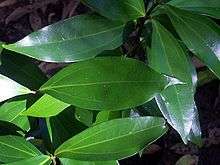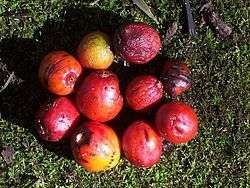Cryptocarya laevigata
Cryptocarya laevigata, known as the glossy laurel or red-fruited laurel, is a rainforest plant growing in eastern Australia. The natural range of distribution is rainforest understorey on fertile soils, from the Richmond River, New South Wales to Cairns in tropical Queensland. Often seen in association with the White Booyong.
| Cryptocarya laevigata | |
|---|---|
 | |
| Glossy laurel | |
| Scientific classification | |
| Kingdom: | Plantae |
| Clade: | Tracheophytes |
| Clade: | Angiosperms |
| Clade: | Magnoliids |
| Order: | Laurales |
| Family: | Lauraceae |
| Genus: | Cryptocarya |
| Species: | C. laevigata |
| Binomial name | |
| Cryptocarya laevigata | |
| Synonyms | |
Description
Cryptocarya laevigata is a shrub or small tree, occasionally reaching 6 metres in height and with a trunk diameter of 8 cm (3.1 in). The bark is brown and smooth apart from vertical raised bumps.
Leaves alternate, elliptical in shape, smooth edged with a long blunt tip. Glossy above and below. The leaf features a mid rib and two other lateral veins, giving a three veined appearance. Other leaf veins indistinct.
Small, cream, scented flowers form on panicles from October to December. The fruit is an orange or red drupe, 15 mm (0.59 in) in diameter. The single woody seed is pointed and prominently ribbed, like many other Australian Cryptocarya seeds. The fruit is ripe from to January to May.
Like most Australian Cryptocarya fruit, removal of the slimy red aril is advised to assist seed germination. Roots and shoots usually appear within three to twelve months.
Uses
The glossy leaves, small size and attractive red fruit make it suitable as an ornamental tree.

References
- "Cryptocarya laevigata". Australian National Botanic Gardens. Retrieved 2009-07-19.
- Floyd, A.G. (1989). Rainforest Trees of Mainland South-eastern Australia. Inkata Press. p. 179. ISBN 0-909605-57-2.
- "Cryptocarya laevigata". PlantNET - NSW Flora Online. Retrieved 2009-07-19.
External links
- "Cryptocarya laevigata Blume". Atlas of Living Australia.